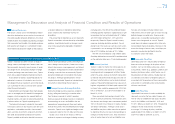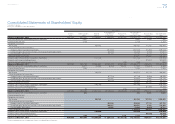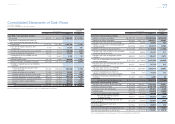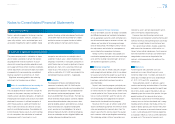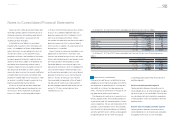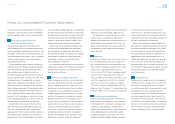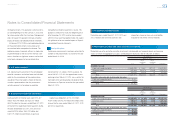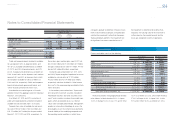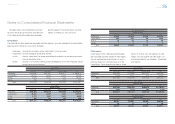Toyota 2013 Annual Report Download - page 79
Download and view the complete annual report
Please find page 79 of the 2013 Toyota annual report below. You can navigate through the pages in the report by either clicking on the pages listed below, or by using the keyword search tool below to find specific information within the annual report.
Toyota Global Vision President’s Message Launching a New Structure Special Feature Review of Operations
Consolidated Performance
Highlights
Management and
Corporate Information Investor InformationFinancial Section
Page 79
NextPrev
ContentsSearchPrint
ANNUAL REPORT 2013
Notes to Consolidated Financial Statements
accrued also contains an estimate of warranty claim
recoveries to be received from suppliers.
In addition to product warranties above, Toyota
accrues for costs of recalls and other safety mea-
sures based on management’s estimates when it
is probable a liability has been incurred and the
amount of loss can be reasonably estimated. Toyota
employs an estimation model, to accrue at the time
of vehicle sale, an amount that represents manage-
ment’s best estimate of expenses related to future
recalls and other safety measures. The estimation
model for recalls and other safety measures takes
into account Toyota’s historical experience of recalls
and other safety measures.
Litigation liabilities are established to cover proba-
ble losses on various lawsuits based on the infor-
mation currently available. Attorneys’ fees are
expensed as incurred.
Research and development costs are expensed
as incurred. Research and development costs were
¥730,340 million, ¥779,806 million and ¥807,454
million ($8,585 million) for the years ended March
31, 2011, 2012 and 2013, respectively.
Cash and cash equivalents
Cash and cash equivalents include all highly liquid
investments with original maturities of three months
or less, that are readily convertible to known
amounts of cash and are so near maturity that
they present insignifi cant risk of changes in
value because of changes in interest rates.
Finance receivables
Finance receivables recorded on Toyota’s consoli-
dated balance sheets are comprised of the unpaid
principal balance, plus accrued interest, less
charge-offs, net of any unearned income and
deferred origination costs and the allowance for
credit losses. Deferred origination costs are amor-
tized so as to approximate a level rate of return over
the term of the related contracts.
The determination of portfolio segments is based
primarily on the qualitative consideration of the
nature of Toyota’s business operations and fi nance
receivables. The three portfolio segments within
fi nance receivables are as follows:
Retail receivables portfolio segment
The retail receivables portfolio segment consists of
retail installment sales contracts acquired mainly
from dealers (“auto loans”) including credit card
loans. These contracts acquired must fi rst meet
specifi ed credit standards. Thereafter, Toyota retains
responsibility for contract collection and administration.
The contract periods of auto loans primarily
range from 2 to 7 years. Toyota acquires security
interests in the vehicles fi nanced and has the right
to repossess vehicles if customers fail to meet their
contractual obligations. Almost all auto loans are
non-recourse, which relieves the dealers from fi nan-
cial responsibility in the event of repossession.
Toyota classifi es retail receivables portfolio seg-
ment into one class based on common risk charac-
teristics associated with the underlying fi nance
receivables, the similarity of the credit risks, and
the quantitative materiality.
Marketable securities
Marketable securities consist of debt and equity
securities. Debt and equity securities designated as
available-for-sale are carried at fair value with unre-
alized gains or losses included as a component of
accumulated other comprehensive income in share-
holders’ equity, net of applicable taxes. Individual
securities classifi ed as available-for-sale are reduced
to net realizable value for other-than-temporary
declines in market value. In determining if a decline
in value is other-than-temporary, Toyota considers
the length of time and the extent to which the fair
value has been less than the carrying value, the
fi nancial condition and prospects of the company
and Toyota’s ability and intent to retain its invest-
ment in the company for a period of time suffi cient
to allow for any anticipated recovery in market value.
Realized gains and losses, which are determined on
the average-cost method, are refl ected in the con-
solidated statements of income when realized.
Security investments in non-public
companies
Security investments in non-public companies are car-
ried at cost as fair value is not readily determinable. If
the value of a non-public security investment is esti-
mated to have declined and such decline is judged to
be other-than-temporary, Toyota recognizes the impair-
ment of the investment and the carrying value is
reduced to its fair value. Determination of impairment is
based on the consideration of such factors as operat-
ing results, business plans and estimated future
cash fl ows. Fair value is determined principally
through the use of the latest fi nancial information.
Finance lease receivables portfolio segment
Toyota acquires new vehicle lease contracts originated
primarily through dealers. The contract periods of these
primarily range from 2 to 5 years. Lease contracts
acquired must fi rst meet specifi ed credit standards
after which Toyota assumes ownership of the leased
vehicle. Toyota is responsible for contract collection
and administration during the lease period.
Toyota is generally permitted to take possession
of the vehicle upon a default by the lessee. The
residual value is estimated at the time the vehicle is
fi rst leased. Vehicles returned to Toyota at the end
of their leases are sold by auction.
Toyota classifi es fi nance lease receivables portfo-
lio segment into one class based on common risk
characteristics associated with the underlying fi nance
receivables and the similarity of the credit risks.
Wholesale and other dealer loan receivables
portfolio segment
Toyota provides wholesale fi nancing to qualifi ed
dealers to fi
nance inventories. Toyota acquires
security interests in vehicles fi nanced at wholesale.
In cases where additional security interests would
be required, Toyota takes dealership assets or per-
sonal assets, or both, as additional security. If a
dealer defaults, Toyota has the right to liquidate any
assets acquired and seek legal remedies.
Toyota also makes term loans to dealers for busi-
ness acquisitions, facilities refurbishment, real estate
purchases and working capital requirements. These
loans are typically secured with liens on real estate,
other dealership assets and/or personal assets of
the dealers.
Selected Financial Summary (U.S. GAAP) Consolidated Segment Information Consolidated Quarterly Financial Summary Management’s Discussion and Analysis of Financial Condition and Results of Operations Consolidated Financial Statements Notes to Consolidated Financial Statements [2 of 44]
Management’s Annual Report on Internal Control over Financial Reporting Report of Independent Registered Public Accounting Firm




